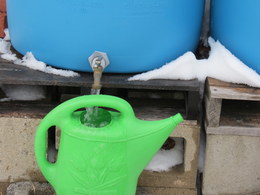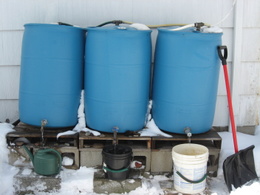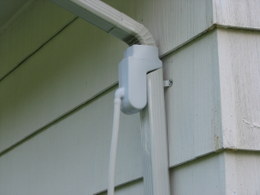Rain Barrels Are Good
for the Environment
Rain barrels capture water from your roof and stores it for later use on gardens or indoor plants.
A rain barrel will save you money! If you use well water, your pump uses electricity and costs you money!
If you use water from a municipal water supply it most likely has chlorine, fluoride and other additives that are not good for your plants; it is metered and costs you money!
Rain water does not have any chemicals that are found in municipal water systems.
Plants Will Be Healthier
Rain water contains dissolved nitrogen and is free soft water containing no chlorine or fluorides and is good for your plants! Your garden and plantings will thrive and love you!
One inch of rain on 1,000 square feet of roof will give you about 600 gallons of water.
Rain Barrel Types and Styles
A rain barrel might be a simple plastic 55-gallon barrel or it could be a fancy ornate rain barrel that looks like a large terracotta pot. There are even rain barrels that look like a brick wall. Rain barrels can range in size from 50 to more than 100-gallons.
Some are open at the top and accept the rain water directly from a down spout. A fine mesh screen should be used to keep leaves from the roof from entering the rain barrel. An advantage of an open top rain barrel is that more water is quickly obtained from even a light shower. A disadvantage is that when the rain barrel is full and a heavy rain comes, the water will spill out over the top and can cause some water erosion problems on the ground. Another disadvantage is that the rain barrel can become a breeding source for mosquitoes.
One way to eliminate mosquitoes is to place a Mosquito Dunk in the rain barrel. These are small briquettes that contain bacillus thuringiensis (BT). A briquette is placed in the rain barrel or even a bird bath, where it floats on the surface and slowly releases the BT into the water. The mosquito larvae consume the BT which kills them before they are able to grow into mature biting adults.
Another method is a closed rain barrel using a diverter located in the downspout. A light rain will leave the diverter and go down a hose to your rain barrel. When the rain barrel is full the diverter will let the water continue past the diverter and on through the downspout. It is completely closed and no water splashes on the ground. Another advantage is that mosquitoes cannot get in and breed inside.
Barrels Need a Safe Solid Base
A 55-gallon rain barrel will actually hold closer to 60-gallons. A U.S. gallon of water weighs 8.35-pounds, therefore the water alone will weigh 501-pounds plus the weight of the rain barrel.
A good height for the rain barrels is 20” to 24” above the ground. If the rain barrel is too low you cannot raise it, but you can raise the pail to whatever height you want. A base that is 24-inches square should be wide enough for almost all types of round rain barrels. A good safe solid base can be made by stacking common 8-in. by 8-in. by 16-in. cement blocks in a square. The heavy weight of the rain barrel will cause the base to sink slightly into the ground. Placing the cement block with the smooth side down will give it a better bearing surface. After the first row is in place and level, add the second row, staggering the joints and then add the third row in the same manor.
To cover the hole in the center use 2x4s, 2x6s or whatever you have to finish the base to place the rain barrel on. If you have shipping pallets available you can take them apart, remove the nails, cut the pieces to length and nail them together.
Landscape timbers or 4x4s could also be used to make the base. You can make the base in 1-piece to accommodate the number of rain barrels you plan to have. Measure your rain barrel(s) to determine how long and wide the base needs to be. Allowing 2-feet for each rain barrel should be a good estimate to use. Be sure to provide enough cross pieces to support the weight of each rain barrel.
Practical experience shows that 1-rain barrel does not provide enough water and that 2 or 3-rain barrels are more likely to be what is needed to get you through the hot, dry days of August.
To keep the area in front of your rain barrel from getting muddy, putting a cement paver or cement block under the faucet to place your pail or watering can on, will do the trick. If you have more than 1-rain barrel, you can place a cement paver under 1-rain barrel to place a 5-gallon pail on, and a cement block under the other rain barrel, to place watering can with its small opening on. Also by starting out with the rain barrels higher, and your garden is not uphill, you can connect a garden hose to reach your garden.
Make Your Own Rain Barrel
You can buy ready-made rain barrels, but with a little bit of work, you can make your own for a fraction of the price.
New and used barrels are available online and in salvage yards, but if you look around you can get them for free. You can find them at car washes as well as many manufacturing companies. Ask your friends and neighbors if the company they work for has any to give away. The next time you are at the car wash ask the owner or manager there if they have one you could have. It is always good to ask if the barrel has been washed out. Most companies out of good safety practices will already have washed them out.
You should not use a barrel that had contained motor oils; any petroleum based product, any herbicide or pesticide.
Various chemicals and acids are used in manufacturing, so you may find a barrel that had held sulfuric acid or phosphoric acid for example. Sulfuric acid has many uses in manufacturing as well as fertilizer manufacturing. Phosphoric acid also has many uses in manufacturing and can be found in many common soft drinks. Dentists also use phosphoric acid to etch teeth prior to filling a cavity.
It is alright to use a barrel that had contained sulfuric acid, phosphoric acid, etc. It is very common to find the original label still on the barrel. If not, ask what was in the barrel so you can make an informed decision on whether you want to use the barrel for a rain barrel.
Do a little bit of investigation before using a recycled barrel to use for a rain barrel.
If you want to see some videos on “rain barrel construction” copy and paste that into the search box of YouTube.com. You will see some that are open on the top that let all of the water from the downspout go into the barrel, but after the barrel is full all of the excess water now overflows onto the ground often making a muddy patch on the ground. A neater way is the closed system using a diverter mounted in line with the downspout. When the rain barrel is not full the diverter lets the water flow into the rain barrel and when it is full the excess water now will flow down the downspout just the way it did before the rain barrel was installed.
If you do not like the color of the recycled rain barrel, it can be painted any color by spraying with Krylon “Fusion for Plastic” paint, which is made for painting plastic.
What Happens in the Winter?

Many of the rain barrels that you can buy, such as the decorative terracotta and plastic rain barrels, may split open and be ruined when the water freezes. With these you need to be sure that you drain out all of the water before the water freezes in the rain barrel.
The recycled commercial barrels that might be blue or black plastic are very strong and usually will not split when frozen solid in the winter. The bottoms may bulge when frozen and tilt a bit, such as the 3-rain barrels in the photo that have been through more than 10-winters and have not suffered any damage.
Even during the winter when the rain barrel is frozen, you can often get some water out of it, when the temperature gets above freezing. If the rain barrel is frozen solid and you are in the snow-belt you can get your rain water by collecting some snow. All you need to do is pack some snow in a pail, bring it inside and let it melt.
Let rain water get to room temperature before watering your houseplants.
Sources:
Garden Watersaver Downspout Diverter
www.gardenwatersaver.com
Garden thoughts:
“If you only do one thing, collect rainwater.”
-Bill Mollison
Garden Spikes newsletters give you timely information once or twice a month. Subscribe Free to the Garden Times newsletter below.
Your email address will only be used to send you a newsletter and will never be sold. You can unsubscribe at any time.


